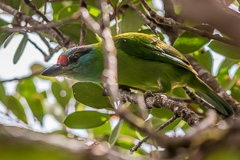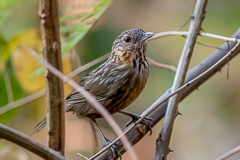Siamese Partridge |
Previously the diversa race of Chestnut-headed Partridge A. cambodiana was treated as distinct. However, as the race chandamonyi in the western Cardamom Mountains, appears intermediate between western Thai diversa and eastern Cambodian cambodiana recent work has lumped the two former species. Restricted to the Cardamom Mountains of southeastern Thailand, where it occurs in evergreen forest between about 800 to 1,500 metres. The only accessible site for this species is Khao Soi Dao Wildlife Sanctuary, where it is necessary to organise a trek up either Khao Soi Dao Nua or Khao Soi Dao Dtai peaks. |
Turquoise-throated Barbet |
This taxon, formerly treated as an isolated race of Blue-thoated Barbet Psilopogon asiaticus, is now treated as distinct. This barbet is restricted to Khao Luang National Park in Nakhon Sri Thammarat province, where it is considered to be fairly common above 850 metres. As no roads or tracks provide access anywhere near this altitude, access to this elevation requires an organised trek and a guide. Due to these access difficulties, and its previous treatment as a race of Blue-throated Barbet, this taxon has largely been ignored to date. |
White-eyed River Martin |
This species was first discovered in 1968 when a few birds were observed roosting within Barn Swallow flocks in reed beds at Bueng Boraphet. A number of specimens was collected and a few more observations were made over the following years, with the last in 1978. Since then, despite repeated attempts to relocate it either in Thailand, where it was assumed to be a winter visitor, Burma or Cambodia, the species has never been refound. Although currently classified as Critically Endangered it is likely extinct. |
Deignan's Babbler |
The taxonominc status of Deignan's Babbler is subject to continuing debate. Most authors now simply merge it into Rufous-fronted Babbler S. rufifrons as an aberrant form, while others treat it as either a subspecies of Rufous-fronted Babbler or as a distinct species. The taxon was originally collected as three specimens from Chiang Dao in 1939. These specimens show some sight differences in morphology and biometrics from other examples of Rufous-fronted Babbler, but it is not clear whether this is simply local variation. Despite repeated searches in the Chiang Dao area only birds showing typical features of rufifrons have been recorded. Birders visiting Chiang Dao should remain alert to the possibility of encountering birds showing characteristics of Deignan's Babbler. |
Rufous Limestone Babbler |
With the recent splitting of Limestone Wren-Babbler Gypsophila crispifrons, into three species, Thailand became the only country to possess populations of all three. The Rufous Limestone Babbler is endemic to central Thailand, with the population centred about the province of Saraburi, northeast of Bangkok. Like all its congeners the species is restricted to limestone karst forest. It is most accessibly found at the temple of Wat Phra Phutthabat Noi, though occurs in much of the karst forest of the region. |


